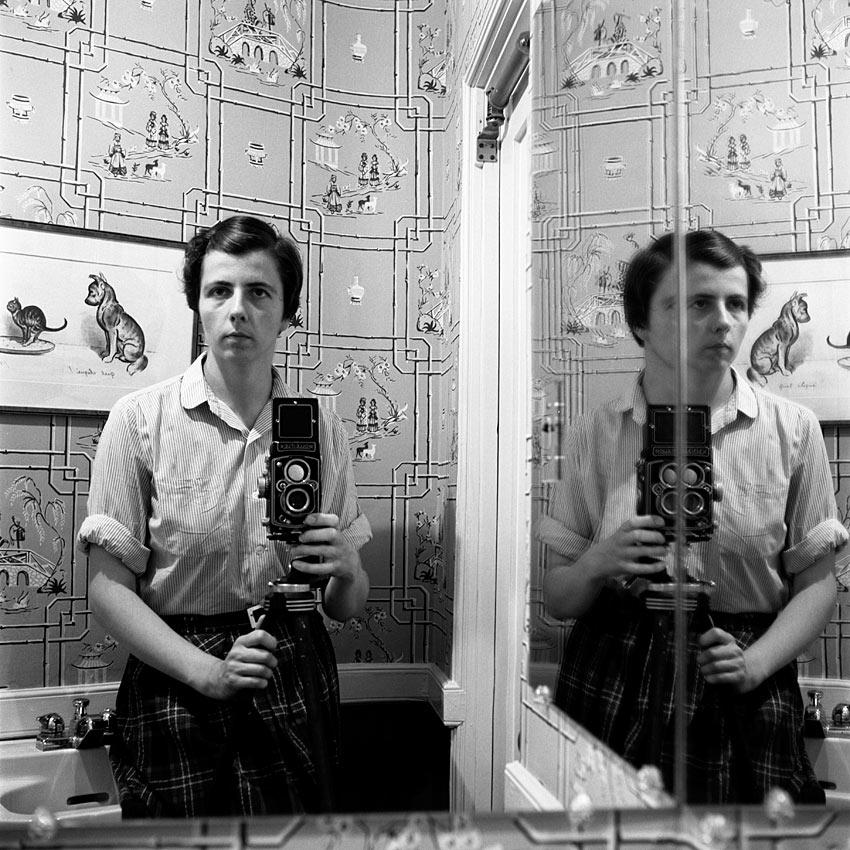9. Street Portraits - Vivian Maier
"A riddle, wrapped in a mystery, inside an enigma."
Vivian Maier was a nanny by occupation, but she has now wowed the world with her photography in which she captured some of the most interesting and peculiar aspects of Urban America from the 1950's.
Vivian did become very poor later in her life, and although several of the children which she nannied got her an apartment and took good care of her, unknown to them there was a storage locker in Maier's name, which due to delinquent payments, was auctioned off. These storage lockers stored Maier's huge collection of negatives which she secretly stashed through her lifetime.
In 2007 Maier's large body of work came to light, it was discovered in a local thrift auction house in Chicago. It was purchased by John Maloof, who discovered Maier's particular eye for photography. From here, Vivian Maier's work would impact the world over and changed the life of Maloof when he brought it to the public's eye.
"It took me days to look through all of her work. It inspired me to pick up photography myself. Little by little, as I progressed as a photographer, I would revisit Vivian's negatives and I would "see" more in her work. I bought her same camera and took to the same streets soon to realize how difficult it was to make images of her caliber. I discovered the eye she had for photography through my own practice. Needless to say, I am attached to her work."
 |
| John Maloof |
"After some researching, I have only little information about Vivian. Central Camera (110 yr old camera shop in Chicago) has encountered Vivian from time to time when she would purchase film while out on the Chicago streets. From what they knew of her, they say she was a very "keep your distance from me" type of person but was also outspoken. She loved foreign films and didn't care much for American films.
Some of her photos have pictures of children and often times it was near a beach. I later found out she was a nanny for a family on the North Side whose children these most likely were. One of her obituaries states that she lived in Oak Park, a close Chicago suburb, but I later found that she lived in the Rogers Park neighbourhood.
Out of the more than 100,000 negatives I have in the collection, about 20-30,000 negatives were still in rolls, undeveloped from the 1960's-1970's. I have been successfully developing these rolls. I must say, it's very exciting for me. Most of her negatives that were developed in sleeves have the date and location penciled in French (she had poor penmanship).
I found her name written with pencil on a photo-lab envelope. I decided to 'Google' her about a year after I purchased these only to find her obituary placed the day before my search. She passed only a couple of days before that inquiry on her.
I wanted to meet her in person well before I found her obituary but, the auction house had stated she was ill, so I didn't want to bother her. So many questions would have been answered if I had."
Using Vivian Maier's work to look at street photography.
 |
| Undated, New York, NY |
I am a huge fan of Vivian Maier's work, especially when it comes to looking at true street photography. Her photographs vary from day to day street shots of people walking, doing their every day routine and then she has portrait photographs, where you know the subject has seen she's taking a photograph.
My favourite thing about Vivian Maier's work is the fact that in some photographs, the subject is completely oblivious, completely unaware, and Vivian is essentially invisible to them. This, personally, is what I consider to be true street photography, being invisible. You capture the true essence of people, of what they do on the street. And there is no interference from the camera.
There's always the possibility that when you're taking photographs of people you do not know, and they realise you're taking a photograph, they will react. They might smile, or they might frown, knowing you're taking a photograph without their consent. Being invisible allows you to capture their true expression, not an expression of shock or uncertainty. This is something, if I were to try more street photographs myself, I would like to capture, but with regards to this brief I must approach the subject.
Here are two of my favourite Vivian Maier street portraits. The subjects aren't smiling or frowning, they're just photographed as they are. Their eyes seem to stand out to me, so clear and crisp, and they stare straight back at you. Something I want to capture in my own street portraits. I also like the relaxed stance that the subject are carrying, no tension, no uncomforted, just as they are. These are true street portraits, and is something I wouldn't mind trying in the future. I also like the effect black and white photography has on the images, the fact that they are black and white add to the authenticity of the photographs in my opinion. Use film for my portraits?
She also had a great sense of composition when taking her photographs. For someone who never studied photography, and it was only her interest that flared her, she developed a particular sense of composition and style throughout her photographs.
On the left hand side here we have one of Vivian Maiers best photographs, in my opinion, with regards to composition. It's a simple photograph of the bottom side of a bridge in New York City. What draws my eye to this photograph is the shadows, and the recurrence of lines throughout the photographs, even the repetition of the windows on the right hand side of photograph adds to its layout and distribution of content.
Links.
- http://www.vivianmaier.com/
- John Maloof flickr Discussion- http://www.flickr.com/groups/onthestreet/discuss/72157622552378986/
- http://vivianmaier.blogspot.co.uk/
- http://www.chicagomag.com/core/pagetools.php?url=%2FChicago-Magazine%2FJanuary-2011%2FVivian-Maier-Street-Photographer%2Findex.php&mode=print






Comments
Post a Comment